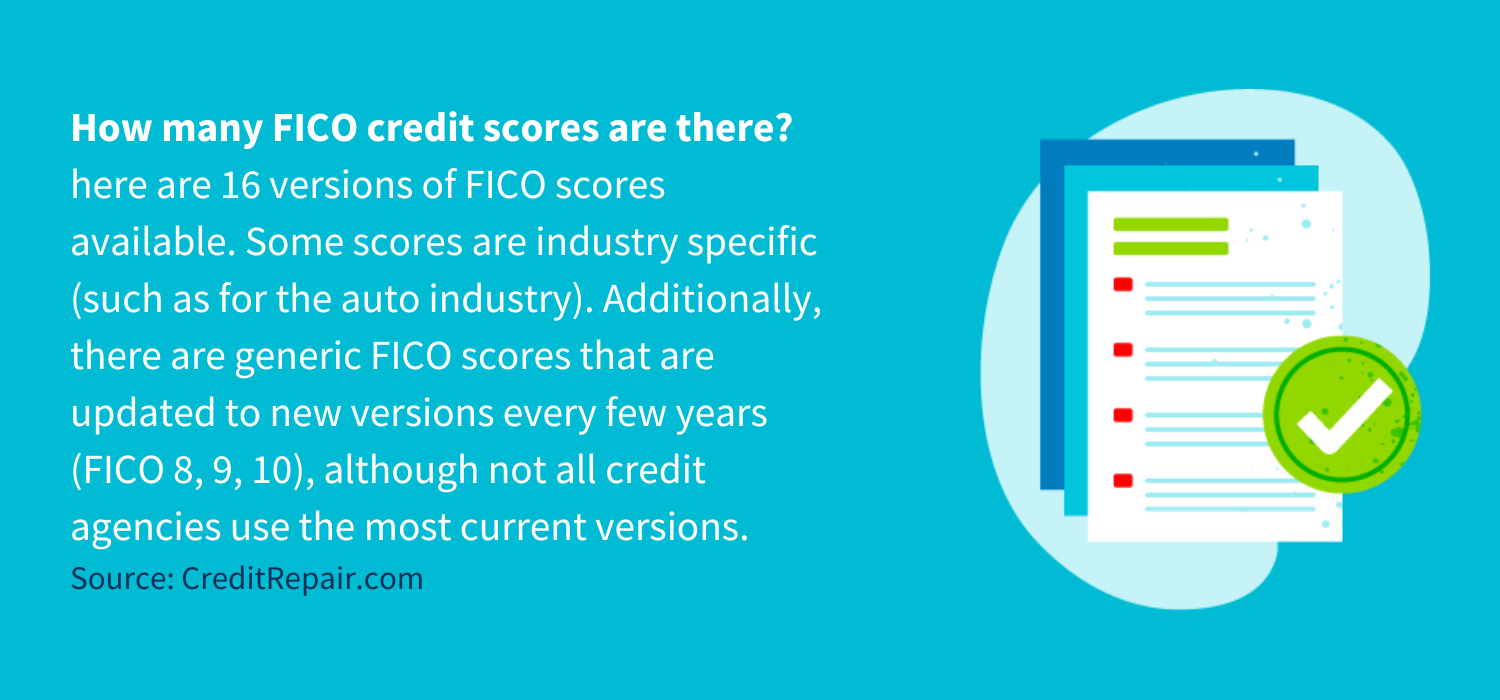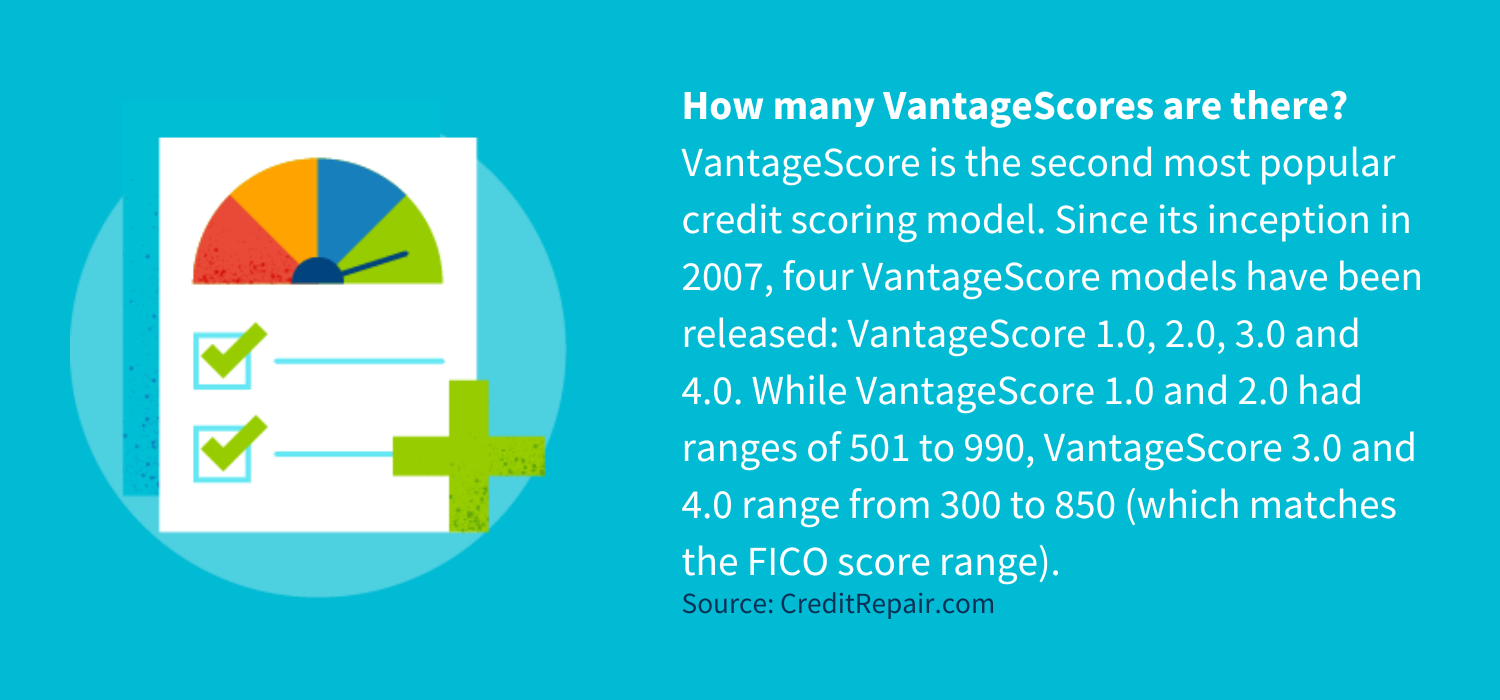
Disclosure regarding our editorial content standards.
If you’ve ever pulled your credit score from various sources, you may have noticed that the scores you received were different. This is because there are many credit scoring models, and your score won’t necessarily be the same across all of them.
A consumer likely has dozens of credit scores associated with them, varying based on which credit score model was used, what version and what credit data was collected.
Why are there different credit scores?
Credit scoring models are a business just like the credit bureaus that use the models, so they change and update based on what the credit reporting industry needs.
There are two major credit scoring models: FICO® and VantageScore®. Additionally, each model has different scoring metrics. While assessing similar attributes, they weigh things slightly differently.
There are even different assessment methodologies for different industries. So not only do you have VantageScore and FICO credit scores, but you also have different scores for each of their models (such as FICO Auto Score 8, FICO 9 and VantageScore 3.0).
How are FICO scores calculated?
Each FICO score version has its own set of parameters for calculations, but some consistent credit history data is used in all FICO scores:
- Payment history (35 percent)
- Amounts owed (30 percent)
- Credit history (15 percent)
- Credit mix (10 percent)
- New credit (10 percent)
How many FICO credit scores are there?

The first FICO score was released in 1989, and today there are 16 versions of FICO scores available. Some scores are industry specific (such as for the auto industry). Additionally, there are generic FICO scores that are updated to new versions every few years (FICO 8, 9, 10), although not all credit agencies use the most current versions. So, in actuality, there are several dozen different models in use.
Below are some examples of various FICO scores, but remember that knowing the ins and outs of each scoring model isn’t vital to having a good relationship with your credit.
Most popular FICO scores
The most widely used FICO score is the FICO 8, released in 2009. However, FICO 9 was launched in 2014 and is a close second in lender use. Compared to FICO 8, the FICO 9 model gives less weight to medical debt and excludes paid collections and reported rent payments.
Most recent FICO scores
The most recent FICO scores are:
- FICO Score 10: The newest general FICO score, this version promises to have improved predictive accuracy. The score ranges from 300 to 850.
- FICO Score 10T: FICO Score 10T is like the general FICO score, but it also includes trended data in its evaluations. This means it looks at past behaviors and predicts what consumers will likely do in the future. Scores are partially based on this prediction.
- FICO Auto Score 10: This is FICO’s latest score for the automotive industry. The FICO Auto Score 10 predicts how likely it is a consumer will pay their car loan. These scores range between 250 and 900.
- FICO Bankcard Score 10: Using a credit score range of 250 to 900, the FICO Bankcard Score 10 predicts how likely a consumer will pay their credit card bills. This newest version promises to be more accurate at predicting how reliable subprime borrowers are.
FICO scores used for home, auto and credit card loans
Different FICO scores can be used for different loans, including mortgages, credit cards and car loans.
- Credit card lenders may choose to pull FICO Bankcard Scores.
- Mortgage lenders will often pull the “generic” FICO scores, such as FICO Score 2 from Experian®, FICO Score 4 from TransUnion® and FICO Score 5 from Equifax®.
How many VantageScores are there?

VantageScore is the second most popular credit scoring model, created by the three major credit bureaus (Experian, Equifax and TransUnion) to compete with FICO. Since its inception in 2007, four VantageScore models have been released: VantageScore 1.0, 2.0, 3.0 and 4.0. These scores have changed a lot over the years. While VantageScore 1.0 and 2.0 had ranges of 501 to 990, VantageScore 3.0 and 4.0 range from 300 to 850 (which matches the FICO score range).
How are VantageScores calculated?
VantageScore uses similar data to the FICO models. For VantageScores, it’s broken down as follows:
- Heavily weighted data: Payment history, credit age, credit mix and credit utilization
- Medium weighted data: Debt outstanding
- Low weighted data: Recent activity, such as new accounts opened and hard inquiries
What other credit scoring models are there?
While most lenders use FICO and VantageScore, other credit scoring models exist. Some of the more popular models are:
- TransRisk (via TransUnion)
- National Equivalency Score (via Experian)
- Credit Xpert Scores
- CE Credit Score
- Insurance Score
Remember that models change over time
Credit scoring models release new versions over time as they need to adapt to the changing consumer marketplace. When the credit scoring models were initially released, a lot of the scoring was done by subjective analysis. This allowed scoring to be far too subjective and opened up the opportunity for fraudulent credit practices or potential discriminatory practices.
Over the years, the government has released the Federal Fair Credit Reporting Act and the Equal Credit Opportunity Act to reduce the subjectivity of credit scoring, so it can be a more fair, transparent and uniform process. These acts prohibit factors such as race, religion, gender, sexual orientation and marital status from playing a role in credit reporting and credit scores.
And in more recent years, other changes have been implemented to address issues with the scoring system. For instance, many of the models have adjusted the weighting or excluded medical debt from credit scores. As a result, the credit scoring models were adjusted in response to the rising complaints of incorrect medical debt data on consumer credit reports.
Statistical or judgmental scoring analysis
There are two types of credit scoring models: statistical and judgmental scoring analysis. A statistical scoring analysis takes data from one or multiple sources, attributes weight to each factor and computes a score. In this model, the process is mostly automated.
The judgmental scoring analysis has a lender look at all the data provided in a credit report (or reports) but also considers alternative data, such as a consumer’s relationship history with the lender and prior experience with others. This model is much less rigid and is typically used by smaller banks and lenders.
What credit score is the best?
No one credit score is superior. It depends on what each lender prefers. For example, you may find your auto lender likes to pull FICO credit scores, while your mortgage lender prefers to use VantageScore.
The main benefit of a credit scoring model is the speed at which it gives lenders data about you. Your lender can quickly get a score that tells them how risky a borrower you likely are, and they can respond to your credit or loan application according to that risk.
Those with high credit scores generally get faster approvals, higher amounts, better loan terms and lower interest rates.
How to know which credit score to check
According to FICO, 90 percent of top lenders use FICO scoring. But that doesn’t mean you know for certain that your lender will use FICO—or even which FICO scores they’ll use. Most lenders do have a preferred model, so before applying, you can ask your lender which credit scoring model they typically use.
How to check your credit scores
All consumers are entitled to one free copy of their credit report (and listed credit score) from each of the three major credit bureaus. You can access your report at www.annualcreditreport.com.
In addition to that, there are many services online where you can pay to access your credit score more frequently.
Lastly, many online banking platforms and mobile apps now offer customers free access to their credit scores with monthly updates.
How to understand your credit score
FICO and VantageScore have slightly different terms for their credit rankings.
FICO
300-579: Poor
580-669: Fair
670-739: Good
740-799: Very Good
800-850: Exceptional
VantageScore
300-499: Very Poor
500-600: Poor
601-660: Fair
661-780: Good
781-850 Excellent
Ways you can raise your credit
The good news is that your credit isn’t set in stone. Regardless of the credit ranking model, you can take action to improve your credit and build healthy financial habits. Some of the steps you can take to improve your credit are:
- Pay down your debts.
- Avoid late payments.
- Keep credit utilization below 30 percent.
- Keep old accounts open.
- Avoid hard inquiries back-to-back.
You should check your credit report often and dispute any inaccuracies or errors. The advisors at CreditRepair.com can work with you to examine your credit report and help you file disputes on inaccurate items.
Note: The information provided on CreditRepair.com does not, and is not intended to, act as legal, financial or credit advice; instead, it is for general informational purposes only.
Questions about credit repair?
Chat with an expert: 1-800-255-0263






